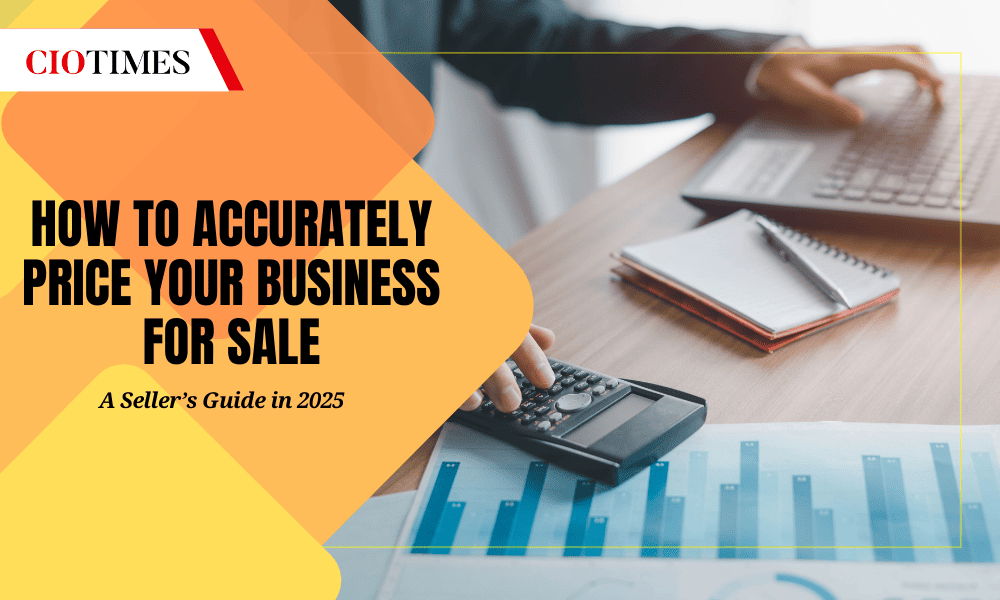As we traverse the changing economic landscape of 2025, one of the most important strategic decisions a business owner can make is understanding when and how to quit. Whether you’re considering retirement, new initiatives, or a merger, evaluating your company’s genuine market value is the first step toward a successful sale.
In this article, CIO Times investigates how sellers may accurately price your business in 2025, assuring maximum value with minimal risk.
Understanding the Importance of Accurate Business Valuation
An accurate business valuation isn’t just a number it’s a powerful negotiation tool and the foundation of a smooth sale. Overpricing can drive buyers away, while underpricing leads to lost wealth. With new trends shaping valuation methodologies in 2025, precise pricing has become more critical than ever.
Key Valuation Methods Used in 2025
1. Earnings-Based Valuation (EBITDA Multiplier Approach)
This remains the gold standard in 2025 for small to mid-sized businesses. Buyers often assess your EBITDA (Earnings Before Interest, Taxes, Depreciation, and Amortization) and multiply it by a market-specific factor.
-
Typical multipliers in 2025 range from 3x to 8x, depending on:
-
Industry growth
-
Revenue consistency
-
Profit margins
-
Operational efficiency
-
Example:
If your business has an EBITDA of $500,000 and your industry average multiple is 4x, then your estimated value is $2 million.
2. Asset-Based Valuation
Used predominantly for asset-heavy businesses (e.g., real estate, manufacturing), this method calculates the net value of tangible and intangible assets minus liabilities.
-
Tangible assets: Machinery, real estate, inventory
-
Intangible assets: Brand reputation, patents, proprietary software
This method is ideal when the company’s earnings don’t reflect its true asset strength.
3. Discounted Cash Flow (DCF) Analysis
A forward-looking approach that uses projected future cash flows and discounts them to present value using a risk-adjusted discount rate.
-
Key for tech, SaaS, and startups in 2025
-
Relies on realistic financial forecasting
-
Shows potential return on investment
4. Market Comparables (Comps)
Analyzing recent sales of similar businesses in your region or industry helps gauge competitive pricing. This method adds a layer of market realism to theoretical calculations.
Critical Factors That Influence Your Business’s Value
1. Financial Performance and Trends
Buyers prioritize revenue trends, profit margins, cash flow stability, and debt levels. In 2025, emphasis has shifted toward sustainable, recurring revenue and low customer churn.
2. Customer Base & Market Positioning
A diversified customer portfolio, long-term contracts, and strong brand loyalty dramatically increase perceived value. Concentration risk (e.g., overreliance on a single client) can lower valuations.
3. Operational Systems and Automation
Scalable and automated operations are considered premium in 2025. Businesses with well-documented SOPs, integrated CRM/ERP systems, and low dependency on owners sell at higher multiples.
4. Industry Growth Prospects
A company in a high-growth industry (e.g., AI, clean tech, digital health) naturally attracts better offers. Businesses in declining sectors may face valuation discounts, regardless of historical success.
Steps to Prepare Your Business for Accurate Pricing
1. Clean Up Financials
Ensure accurate, audited, and updated financial statements for the past 3–5 years. Eliminate personal expenses and reconcile all transactions to avoid red flags during due diligence.
2. Organize Legal and Operational Documentation
Compile:
-
Articles of incorporation
-
Business licenses
-
IP ownership documents
-
Vendor and client agreements
Being “due diligence ready” reassures buyers and supports your asking price.
3. Reduce Owner Dependence
If the business cannot operate without you, its value diminishes. Train a capable management team and decentralize decision-making before entering the market.
4. Improve Digital Presence
In 2025, digital footprints matter. Businesses with strong SEO, positive reviews, active social media, and optimized websites gain higher trust—and higher offers.
How to Choose the Right Business Valuation Expert
Not all valuators are created equal. Look for:
-
Certified Business Appraisers (CBAs) or Chartered Business Valuators (CBVs)
-
Industry-specific experience
-
Transparent methodology and reports
-
Alignment with 2025 market trends and legal standards
Avoid low-cost calculators or outdated valuation models. A few extra thousand dollars for professional valuation can result in hundreds of thousands more in sale value.
When to Use a Business Broker or M&A Advisor
If your business is valued at over $1 million, hiring an experienced business broker or M&A advisor is highly advisable. These professionals:
-
Market your business confidentially
-
Vet and qualify potential buyers
-
Negotiate deals that align with your exit goals
-
Handle complex legal, financial, and regulatory tasks
In 2025, many sellers also use AI-powered valuation platforms in conjunction with human advisors for optimal results.
Common Pricing Mistakes to Avoid in 2025
1. Overestimating Future Potential Without Evidence
Optimism without supporting metrics leads to inflated valuations that collapse under scrutiny.
2. Ignoring Market Conditions
Interest rates, industry shifts, and buyer sentiment all affect pricing. What was true in 2023 may not hold in 2025.
3. Failing to Benchmark Against Comps
If similar businesses in your industry are selling at 5x EBITDA, pricing yours at 8x without justification won’t attract real buyers.
Strike the Right Balance for a Profitable Exit
Accurately pricing your business is an art backed by science. In 2025’s competitive M&A landscape, sellers who prepare early, rely on data, and leverage professional expertise secure the best outcomes. Whether you’re seeking retirement, new ventures, or strategic growth through acquisition, the key lies in a well-informed, buyer-aligned valuation.
Don’t leave money on the table. Know your worth and prove it.
If you want to read exclusive interview of leaders





